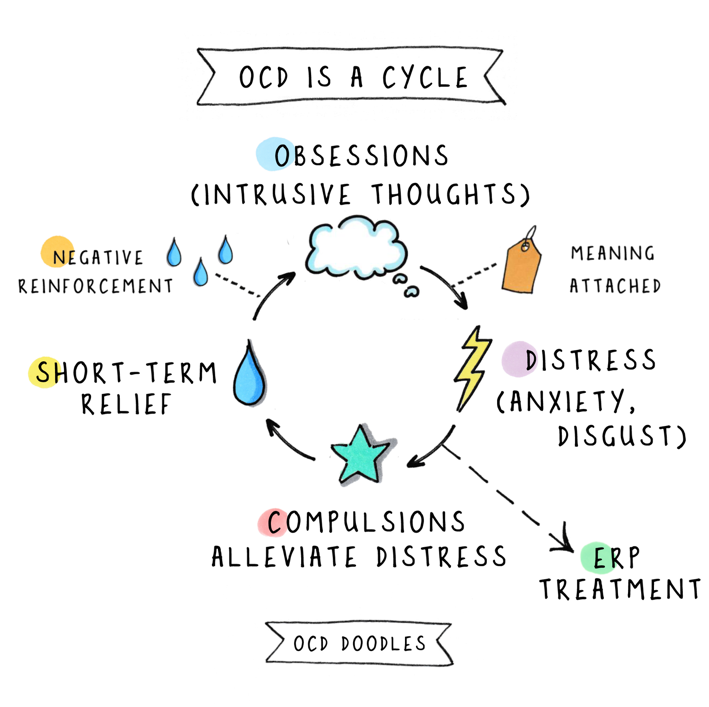
Obsessive-Compulsive Disorder (OCD)
- Home
- OCD
- What is OCD?
Understanding OCD

What is OCD?
Obsessive-Compulsive Disorder (OCD) is a chronic mental health condition characterized by unwanted, intrusive thoughts (obsessions) and repetitive behaviors or mental acts (compulsions) that an individual feels driven to perform. These obsessions and compulsions can significantly interfere with daily life and cause considerable distress.

The Vicious Cycle of OCD
The vicious cycle of OCD involves a repetitive and escalating pattern of obsessions and compulsions that reinforce each other. For example:
- 1. Obsessions: A person experiences an intrusive, unwanted thought, image, or urge expectedly or unexpectedly. This can feel uncontrollable, and cause distress.
- 2. Emotional Distress: This obsession triggers intense emotions (i.e. fear, anxiety, shame, guilt, or disgust). The person might feel overwhelmed and seek relief from this distress.
- 3. Compulsions: In response to the distress caused by the obsessions, the person feels compelled to perform specific behaviors or mental acts (rituals). These compulsions are intended to reduce the anxiety or prevent a feared event or situation (i.e. washing, checking, counting, going over events in their mind, or repeating actions).
- 4. Temporary Relief: Performing the compulsion provides temporary relief from the distress caused by the obsessions. The person might feel a momentary sense of calm or reassurance.
- 5. Negative Reinforcement: The temporary relief reinforces the compulsion, making it more likely that the person will perform the ritual again the next time they experience an obsession. This reinforcement strengthens the association between the obsession and the compulsion.
- 6. Intensification: Over time, the obsessions and compulsions become more frequent and intense. The individual may need to perform the rituals more often or more elaborately to achieve the same level of temporary relief.
- 7. Increased Interference: As the cycle continues, it begins to interfere more significantly with the person's daily life. The time and energy spent on obsessions and compulsions can affect their self-care, productivity, relationships, and overall quality of life.
- 8. Entrenchment: The cycle becomes deeply entrenched, making it difficult for the individual to break free from the patterns of obsessions and compulsions. This can lead to increased frustration, hopelessness, and a sense of being trapped.


Symptoms of OCD
OCD symptoms are typically divided into two categories: obsessions and compulsions.
- • Persistent, unwanted thoughts, images, or urges that cause significant anxiety or distress.
- • Common obsessions include fears of contamination, harming oneself or others, intrusive sexual or violent thoughts, and/or a need for symmetry or exactness.
Obsessions:
- • Repetitive behaviors or mental acts performed in response to obsessions or according to rigid rules.
- • Common compulsions include excessive hand washing, checking, counting, arranging, and seeking reassurance.
Compulsions:

Impact on Daily Life
OCD can affect various aspects of an individual's life, including:
- • Work or school performance
- • Personal relationships
- • Daily routines
- • Physical health, due to compulsive behaviors (e.g., skin damage from excessive washing)

Diagnosis and Treatment
Diagnosis
OCD is diagnosed through a clinical assessment conducted by a Physician, Nurse Practitioner, Psychiatrist or Psychologist. This may include discussing the person's symptoms and their impact on daily life, and any family history of mental health experiences.
Treatment Options
Exposure and Response Prevention (ERP): ERP is a type of Cognitive Behavioral Therapy (CBT) that is highly effective in treating OCD. ERP involves a person stepping into feared situations or thoughts (exposure) and working to refrain from engaging in the compulsive behaviors (response prevention). Over time, this helps reduce the anxiety associated with obsessions and the urge to perform compulsions. Medication: Selective Serotonin Reuptake Inhibitors (SSRIs) are commonly prescribed medications that can help reduce OCD symptoms. In some cases, a combination of medication and therapy may be the most effective approach.
Self-Help and Support: Joining a support group, practicing stress-reduction techniques, and educating oneself about OCD can also be beneficial.
Seeking Help
If you or someone you know is struggling with OCD, it is important to seek professional help. As a Registered Social Worker in Ontario who is
passionate about OCD, I am here to provide therapeutic support and CBT/ERP treatment.
Please feel free to contact Pothos for more information or to schedule a consultation.

Let's Connect
We know that finding the right therapist can feel overwhelming. If you're struggling with navigating various difficulties and stressors in your life and want support finding a different path, please reach out to us so we can book a brief call.
During this informal conversation, we can discuss your needs and practical considerations (such as fees, timing of sessions etc.) and determine together whether Pothos is the right fit for you moving forward.
Based on our discussion, if we discover that the fit isn't right, we can provide suggestions for alternative options and considerations.
info@pothoscounselling.com
(249) 505-0588
Please ensure that when you send emails to Pothos Counselling and Consultation Services, that you check your junk folder for our response, sometimes correspondence gets interrupted or held up as a result